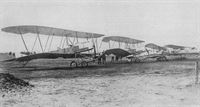
Описание
Страна: Германия
Год: 1913
J.Herris Albatros Aircraft of WWI. Vol 1: Early Two-Seaters (A Centennial Perspective on Great War Airplanes 24)
Albatros Pre-War Aircraft
1913 was a big year for Albatros, which introduced a number of new designs. Albatros started 1913 with the Argus-powered DE followed by a series of Taube monoplane designs.
<...>
Perhaps the most significant 1913 Albatros design was the WDD (Wasser Doppeldecker Doppelsitzer - water biplane two-seater) that was produced in small quantities for the Navy and was retroactively designated the Albatros W.1.
<...>
Описание:
- J.Herris Albatros Aircraft of WWI. Vol 1: Early Two-Seaters (A Centennial Perspective on Great War Airplanes 24)
- M.Dusing German Aviation Industry in WWI. Volume 1 (A Centennial Perspective on Great War Airplanes 84)
- Журнал Flight
Фотографии
-
J.Herris - Albatros Aircraft of WWI. Volume 1: Early Two-Seaters /Centennial Perspective/ (24)
Albatros Militar Doppeldecker, 1913.
-
J.Herris - Albatros Aircraft of WWI. Volume 1: Early Two-Seaters /Centennial Perspective/ (24)
Lineup of pre-war Albatros-built aircraft. Two early DE biplanes are in front. The third aircraft in line isa license-built Breguet; an F2 based on the Farman is at the far right. (Peter M. Bowers Collection/The Museum of Flight)
Другие самолёты на фотографии: Albatros Farman F1 / F2 - Германия - 1910Breguet 3 - Франция - 1910
-
Jane's All The World Aircraft 1919 /Jane's/
Earlier type of Albatros biplane
-
J.Herris - Albatros Aircraft of WWI. Volume 1: Early Two-Seaters /Centennial Perspective/ (24)
Albatros continued to develop biplanes beyond their biplane Taube designs with the result shown here, the DE, a design that previews later Albatros B-types. The wings have lost most of the Taube planform and the interplane strut design is simplified. These DEs mounted the lower wing below the fuselage; others had the lower wing attached to the fuselage. Pilot and observer have some distance between their cockpits, which impeded in-flight communication. The nose radiator and wood fuselage construction are notable. (Peter M. Bowers Collection/The Museum of Flight)
-
J.Herris - Albatros Aircraft of WWI. Volume 1: Early Two-Seaters /Centennial Perspective/ (24)
The Albatros DE displaying its wood veneer fuselage and nose radiator. The lower wings are below the fuselage.
-
J.Herris - Albatros Aircraft of WWI. Volume 1: Early Two-Seaters /Centennial Perspective/ (24)
A straight-forward floatplane development of the new Albatros DE biplane resulted in the Wasser-Doppeldecker Bodensee for pre-war contests. (Peter M. Bowers Collection/The Museum of Flight)
-
Журнал - Flight за 1914 г.
4. The Albatros Tractor seaplane.
-
J.Herris - Albatros Aircraft of WWI. Volume 1: Early Two-Seaters /Centennial Perspective/ (24)
The 1913 Albatros Militar-Doppeldecker (Military Biplane) used a 'brow' radiator and the wings were attached to the lower fuselage longerons.
-
J.Herris - Albatros Aircraft of WWI. Volume 1: Early Two-Seaters /Centennial Perspective/ (24)
The next step in development of the new Albatros biplane was the 1913 Albatros Militar-Doppeldecker (Military Biplane). The nose radiator has been replaced by a radiator over the engine and the vertical tail has been redesigned and looks more robust. The cabane struts have been simplified and the lower wings now attach directly to the fuselage, eliminating a number of drag-producing struts. The wood veneer fuselage has been retained. (Peter M. Bowers Collection/The Museum of Flight)
-
Форум - Breguet's Aircraft Challenge /WWW/
Albatros Doppeldecker type, quite likely a training machine, given the skids and the apparent comfort provided to the instructor in back. Its 6-cylinder engine was either a Daimler Mercedes D.I or D.II of 100 or 120 hp. Very similar to the Albatros "Uhu" Schuldoppeldecker (training biplane) dating from 1913, described by Lange as having many of the same qualities.
-
M.Dusing - German Aviation Industry in WWI. Volume 1 /Centennial Perspective/ (84)
Advertisement 1914, Motor.
-
Журнал - Flight за 1914 г.
4. The Albatros Tractor seaplane.



















